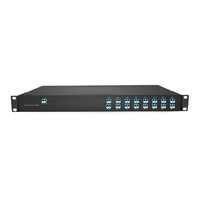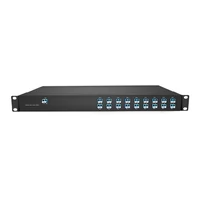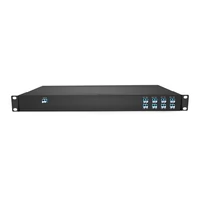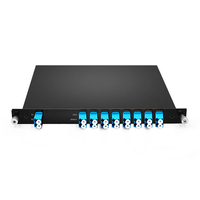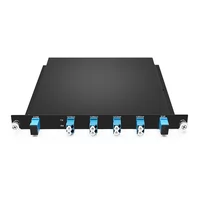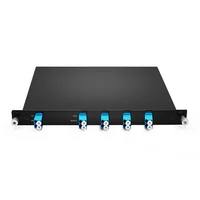A CWDM Mux Demux or Coarse Wavelength Division Multiplexing is crucial in the optical communication system because it can improve channel efficiency. This tutorial provides an in-depth understanding of the CWDM technology and its importance in enhancing telecommunication systems. CWDM also makes it possible to reduce costs by using multiple wavelengths to send signals through one fiber, reducing bandwidth wastage. This paper is based on the technical information regarding CWDM Mux Demux modules, describing their purposes, advantages, and use areas across different industries. With the help of this detailed description, readers will understand better how optical communication systems based on CWDM technology, such as 8-channel CWDM systems, will look and how they will work in the future.
Table of Contents
ToggleWhat is CWDM and How Does it Work in Optical Networks?

CWDM, short for Coarse Wavelength Division Multiplexing, transmits several optical signals over a single fiber using different light waves. This is done using Mux Demux modules that efficiently segregate and combine these waves. CWDM enables efficient bandwidth usage in optical networks by transmitting several data streams at different wavelengths, usually 20 nanometers. This technology enhances fiber capacity with no additional cabling, tremendously lowering the infrastructure cost. Furthermore, CWDM is a low-cost technology that adds network capacity while being simple and flexible in design.
Understanding CWDM Technology and Its Applications
The CWDM technology uses a range of optical filters incorporated in its Mux Demux modules to split and combine several optical signals per their specific wavelengths. In this way, many channels can be accommodated in one fiber, each at a particular wavelength. The flexibility in the design of CWDM systems makes them valuable, particularly for metropolitan area networks (MANs) and cable television systems, whereby bandwidth enhancement is required. By utilizing WDM management of fibers, CWDM minimizes the operational and capital costs of increasing the network’s capacity. Its applicability is in many sectors, including the telecommunications sector, data centers, and enterprise communications, with an easy and relatively cheap mode of responding to the increasing demand for data.
Key Differences Between CWDM and DWDM
Wavelength Division Multiplexing cwdm and Wavelength Division Multiplexing dwdm differ in width between the channels and the capacity. For instance, CWDM utilizes wider channel gaps of 20 nanometers, which allows a single fiber to carry a maximum of 18 channels and hence is preferred in short and medium-range transmissions since such situations demand low bandwidth and are cost-effective. On the other hand, his approach, Although Wavelength Division Multiplexing dwdm incorporates the use of narrow channel gaps, which can allow nominally 96 channels, its primary focus is cost-efficient tolerant environments and long-range communications. Moreover, most of the Wavelength Division Multiplexing dwdm networks now have a throughput frequency of 1400 gig nominations; this means enabling temperature controls and amplification technologies over large distances where necessary; however, in environments where no low bandwidth is required coolers and complex elements such as shapers offer reasonable applications at a lower cost.
The Role of CWDM in Passive Optical Networks
CWDM represents a cost-effective approach that uses the existing fiber infrastructure in passive optical networks (PONs) to decrease operational expenses without compromising functionality. In PONs, CWDM allows the transmission of manifold data signals over a single fiber cable by using different light wavelengths for each signal. This feature increases the network’s bandwidth without the installation of additional fibers, which is particularly useful in applications with lower bandwidth requirements, such as those using 10G technologies. Additionally, because it is a passive device, CWDM has a simple structure that minimizes the upkeep and operational load, consistent with the passive structure of PONs. The application of CWDM in these networks makes it easier to scale the network to accommodate more services and users.
How Does a CWDM Mux Demux Module Operate?
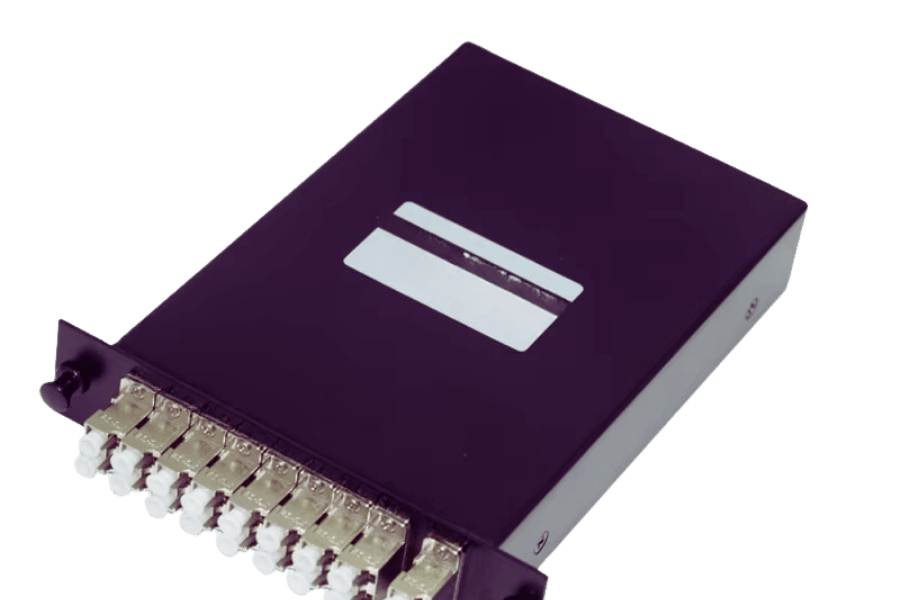
Exploring the Functionality of Mux Demux
CWDM Mux Demux is an active device containing MUX, which Combines all wavelengths from the input and demultiplexes separate wavelengths as its output. CWDM Mux Demux is used inside MPTP systems, allowing the optical network to have a P2MP configuration. Multiplexing enables the combination of many optical signals into one through MUX. The role is that during the transmission, optical signals are combined through Wavelength Division Multiplexing (WDM), and after reception, they need to be separated or extracted back into their forms – a process known as DWM. The combination of optical components that perform this function is designed for a nominal range of over 1270 to 1610 nanometers.
CWDM Mux Demux devices can reduce the number of electronic equipment since optical fiber and passive CWDM components support the wavelength allocation automatically without consuming any electrical power. Due to wide channel separation, the modules allow only a few channels, extending the coverage but maintaining low cost and operational investments. Their deployment improves the utilization of the network by efficiently increasing the available bandwidth along the already existing fiber deployed. CWDM Mux Demux modules complement other network elements in designing an efficient network due to their compact design and flexible network deployment.
Advantages of Using a CWDM Mux Demux Module
The adoption of a CWDM Mux Demux module in optical networks has quite several benefits:
- Cost-Effectiveness: Increasing the network’s capacity with CWDM technology is relatively cheap. Because it is passive, the Mux Demux plugs depopulate does not need electrical power to process any signals, significantly reducing operational costs.
- Increased Bandwidth: These modules increase the bandwidth of already existing fiber optic sites by allowing the increase of the number of optical signals without having to lay more fibers.
- Scalability and Simplicity: CWDM Mux Demux modules are easy to scale due to their simple modular design. Network operators can easily add more channels or delete existing ones in response to increased network traffic without any changes to the infrastructure.
These benefits enhance the utility of CWDM Mux Demux modules in contemporary optical networks with the ability to support flexible and cost-effective network improvements.
Standard Configurations: 8 Channel and Beyond
CWDM Mux Demux modules go hand in hand with different set-ups, one of them being an 8-channel configuration, which is a favorite as it has an economical appeal and a sound capacity. This kind of setup makes it possible to transmit the data across eight different wavelengths using fewer resources and optimizing the data traffic in the network. The modules are expandable beyond the 8-channel configuration, allowing up to 16, 18, or 40-channel configurations. These higher configurations address high-density network requirements and are ideal for serving metropolitan areas and long-distance data transmission. The nature of these configurations allows for the growth of the network in the future and, therefore, provides a strong foundation for development that will align with the growing technology.
How to Choose the Right CWDM Mux Demux for Your Network?
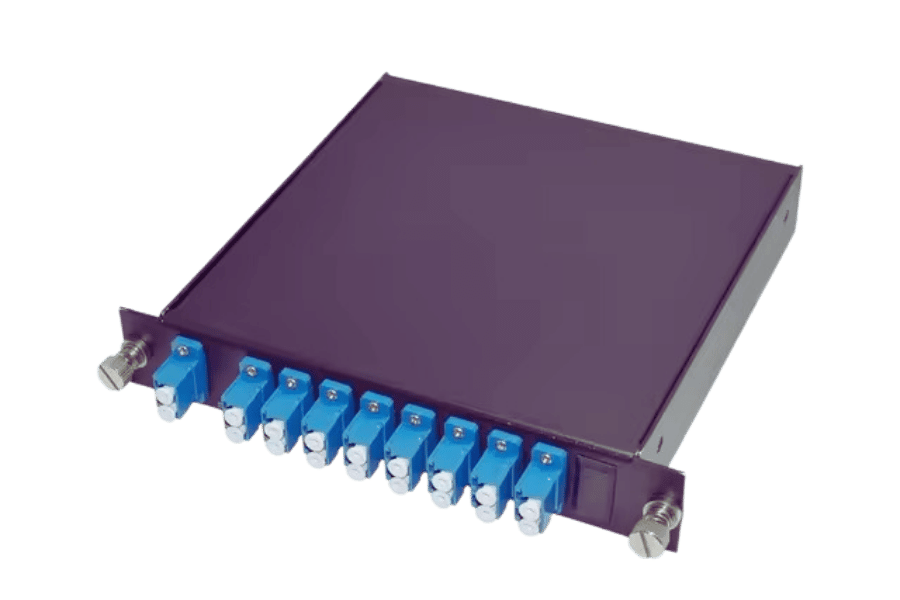
Factors to Consider When Selecting a Module
Certain factors must be considered to achieve optimal compatibility. Consider these when choosing your network’s CWDM Mux Demux module.
- Channel Count: The most crucial factor is determining the required channels. The current network capacity and the possibility of further expansion should help them decide on the standard options of 8, 16, or even more channel counts.
- Insertion Loss: This parameter reflects the module’s signal strength loss at the point of transmission. Lower insertion loss is desirable because it would mean smooth data transmission, enabling reduced amplification and thereby minimizing costs.
- Physical Size and Form Factor: The module’s shape and size should not clash with the network’s current setup, such as the racks or cabinets. Small form factors would be pretty helpful where space is limited.
- Operating Wavelength Range: Integrating the modules or components is essential while accommodating the wavelength range of the parts already there. The modules have to be able to support those wavelengths.
- Temperature Range and Related Ecological Conditions: The module must function under specified operating conditions, including temperature ranges. Choosing a module with the proper operating temperature range ensures the network functions properly.
- Compliance with Network Standards: This way, you guarantee that the module complies with the standards and requirements of the networks in question, such as ITU-T G.694.2, and assure future interconnectivity and expandability of the network.
- Vulnerability and Warranty: If the vendor is ever willing to provide its clients with a dependable warranty, this would positively affect how maintenance is carried out and the resilience of the systems, thus lowering downtime.Trust and Have peace of mind with reliable technical support and comprehensive hardware warranties every day.
Using this data-driven model, one can confidently evaluate the Customer’s Network and the capabilities of the installed modules and begin to deploy robust and easily manageable network architecture.
Channel Spacing and Its Impact on Performance
The performance, as well as the efficiency of the optical systems, relies heavily on the channel spacing. It consists of the frequency division of channels to prevent interference between the channels while simultaneously trying to make full use of the available bandwidth. For example, if a narrower channel width is adopted (50 GHz and less) within a particular band, more channels are allowed, enhancing the overall capacity. On the other hand, this entails introducing more precise filters and complex modulation techniques to prevent crosstalk interference and maintain the signal’s integrity. On the other hand, wider channels result in the degradation of spectral efficiency while facilitating easier channel separation and more robust signal transmission. So, optimizing the channel spacing is a crucial issue, and it necessitates making certain compromises, in this case, between the data rate and the quality of service. The best-known strategies in this regard have transformed modern networks due to the changes in technology and modulation formats.
Comparison: Single-Fiber vs. Dual-Fiber Modules
A single-fiber module uses a single strand of fiber for transmission and receiving data by using different wavelengths at each end. This capability uses the already existing fiber infrastructure and decreases the cost of deployment. This holds particularly true in fiber-starved environments and sometimes helps in more efficient network topology, especially when deploying a splitter for best resource use. However, it requires sophisticated wavelength handling and can cause a rise in performance metrics owing to bidirectional communication.
In contrast, dual-fiber modules utilize one fiber strand for transmitting data, whereas another strand is used for reception. This prevents the complexities associated with wavelength separation in a single-fiber module. Such a separation allows for better network performance by alleviating possible interferences. Though it uses more fiber resources, dual-fiber configurations are much simpler in design and are capable of hyping the stability and robustness of a high bandwidth network. Network characteristics, cost, and future extensibility determine the final polarity between fiber single and fiber’s dual modes.
Integration of CWDM Mux Demux with Existing Fiber Infrastructure
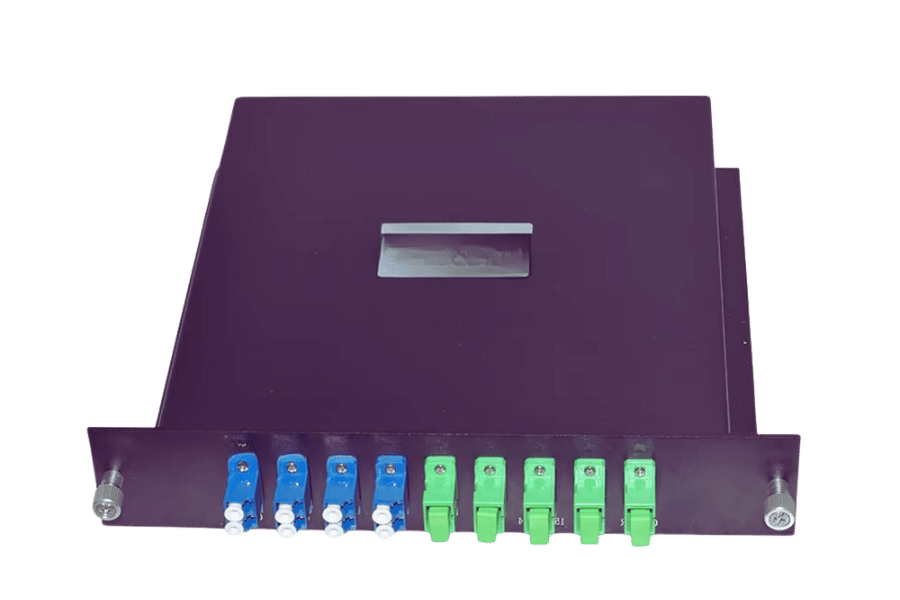
Seamlessly Incorporating Fiber Optic Cables
Integrating CWDM Mux Demux into already established fiber optic Installations should be done with proper planning to minimize investment and time. To begin with, it is essential to assess whether the existing fiber network has the capacity and ability to work with CWDM. A full-scale network survey will be conducted to find potential weaknesses and dead parts of the fiber network that hamper integration. Second, a sound approach and adherence to accepted installation practices will help avoid or reduce complications during installation. This involves designing a detailed plan to connect the cables to the CWDM Mux Demux units, ensuring that compatibility with existing network protocols is maintained. Last but not least, intensive diagnostics and confirmation of the parameters after integration are the most critical conditions for measuring the success of this integration in terms of requirements and service quality. Regular maintenance and monitoring will also support the smooth integration by ensuring that challenges that may be encountered are solved instantly.
Understanding Wavelengths and Optical Multiplexing
Comprehending optical multiplexing and wavelengths is well-defined in the context of sending multiple signals via fiber optics with varying light wavelengths. To my knowledge, optical multiplexing, more specifically, Coarse Wavelength Division Multiplexing (CWDM), is an efficient way of using fiber network capacity without the need for additional cabling since it allows for the use of different wavelengths. Various data signals are combined into one channel using the technology, which uses an array of wavelengths, 20 nanometers on average, as a spacing. This application is handy for metropolitan area networks and other topologies where cost savings on infrastructure are a significant factor. Furthermore, with the aid of duplex connectors, a more careful management of these wavelengths would allow for the transmission of multiple data streams without any form of interference, increasing the bandwidth and improving the network even more.
Leveraging Existing Fiber Media for CWDM Networks
To take advantage of the existing fiber media for CWDM networks, it is crucial to know how to use the present assets best to ensure that more data traffic can be hosted in the future. As major reports show, CWDM can increase the network capacity without deploying additional fiber, which is economical and covers the critical expectations for network growth. The implementation uses wavelength multiplexing to avoid impediments while enhancing the value of the existing properties. It is quite an improvement that when CWDM is incorporated into the fiber networks and 8-channel CWDM technology is adopted, there is an increase in the bandwidth capacity to support the current and future loads of the network in a more planned manner. The network infrastructure will still need to be evaluated and upgraded occasionally to ensure that the network is functioning correctly and in line with relevant technological advancements.
What Are the Best Practices for Installing CWDM Modules?

Installation Tips for 1U 19″ Rack Mount
Installing your CWDM Modules in a 1U 19’’ rack mount is simple if you ensure your rack doesn’t wobble while being installed. Use an arm that manages your cabling for strain-relief purposes and organization. Next, always clean out all SFP connectors and CWDM module slots to prevent connection problems. Make gentle cradle movements until the modules lock into place in the appropriate slots. Once installed, remember to check the room temperature and environment, for too much heat will disrupt performance. Keep a close seal of all the configurations in the order you find them because you will be using them for reference in future maintenance. If followed, this ensures the best working system for your CWDM.
Managing Insertion Loss and Maintaining Signal Quality
Insertion loss is a crucial phenomenon in fiber optics. To effectively manage insertion loss and communication in a fiber optic network, following strict installation measures and regularly performing maintenance is essential. The first step is to ensure that fiber interfaces are well seated and are free from contamination because contaminates increase insertion loss. Use good quality fusion splicing techniques to ensure minimum loss at this point. Use Optical Time-Domain Reflectometers (OTDR) to troubleshoot faults or areas with excessive losses in the network. Also, attenuators achieve balance in the signal so one channel does not become too strong, causing saturating or weak signal levels. Design and implement proper power budget monitoring so that the needs of the network and its growth potentials do not change. Regular evaluation and recalibration of devices will also further stiffen performance and the signal in general. Following these measures, there will be flawless signal transmission, hence efficient transmission of messages over the fiber network.
Ensuring Optimal Operating Temperature and Environment
Specific parameters, including humidity and temperature, may be particularly crucial along with the equipment operating environment of fiber optic systems, especially in a CWDM configuration. As elite resources state, it is necessary to consider a room air temperature set within the limits given by the equipment manufacturer. Any deviations from set standards may result in decreased performance and even damage to the equipment within a short span. Nonetheless, the relative humidity should not drop below forty percent or exceed sixty percent to eliminate moisture problems. Environmental monitoring systems can be beneficial in helping track these amounts and provide warning messages whenever the levels are before the acceptable range. Also, provisions must be made for proper air circulation, and air conditioning or HVAC systems must be installed for heat removal. HVAC systems do not need much guidance for routine activities to prevent breakdowns. This would significantly protect the reliability and efficiency of the fiber optic network.
Reference Sources
Frequently Asked Questions (FAQs)
Q: What is a CWDM Mux Demux, and how does it work?
A: A CWDM Mux Demux is an optical device that enables the interconnection of several channels into one FC/PC connector. It employs coarse wavelength division multiplexing to merge signals with various wavelengths into one fiber and then unbundle the wavelengths at the other end.
Q: How does OADM work in contrast to Mux Demux of CWDM?
A: An Optical Add-Drop Multiplexer, or OADM, replaces the restriction of only combining several wavelengths into an optical signal, allowing particular optical wavelengths that transit through the OADM unit to be added or dropped according to the network requirements.
Q: What role does a monitor port play in a CWDM system?
A: A monitoring port allows tapping an optical signal while the data continues to go through, making it possible to perform diagnostics and some performance measurements in the CWDM system. It aids in preserving optical signal quality by improving the optical signal’s general condition.
Q: What is the distinction between single-fiber and dual-fiber CWDM Mux Demux?
A: With single-fiber CWDM Mux Demux, only one fiber sends and receives optical signals. On the other hand, dual-fiber CWDM Mux Demux uses two fibers, one for transmission and the other for reception, which doubles the number of channels available for data transfer.
Q: Can you tell us how 8-channel CWDM affects the network?
A: An 8-channel CWDM can be an asset in a network as it allows eight different wavelengths, or channels, to be multiplexed on one fiber. This feature is vital in increasing bandwidth and enabling multiple data transfers simultaneously without the need for more fiber optic cables to be laid out.
Q: What advantages can be derived by utilizing an LGX module within a CWDM system?
A: The LGX modules standardize and provide compact mounting, which enhances the flexibility and scalability of the CWDM systems. They are also optimal in data centers and telecom racks, facilitating the embedding of channel CWDM Mux Demux functions into existing rack chassis.
Q: What role do CWDM transceivers play in CWDM Mux Demux modules?
A: Oxygen transport subsections arise when transmitting information around large distances through WDM or CWDM; conversion from electrical signals to optical signals and vice versa must be undertaken. This is where end CWDM channels are positioned to fit within the working environment of the surrounding MUX termination modules.
Q: In your opinion, why are express and expansion ports relevant in CWDM systems?
A: Express ports widen the system, especially when further nodes or channels have to be integrated in the future. This modification is, however, achieved by simply allowing specific wavelengths to pass through the system as they are. Expansion ports serve the same purpose of interlinking one or more CWDM modules.
Q: What role do fiber patch cables have in CWDM systems?
A: Fiber patch cables are installed to interconnect the CWDM Mux Demux modules with switches, routers, and other relevant network components. These PW fiber cables facilitate the stability of the optical signal when propagated across the network.
Q: What role does wavelength division multiplexing hold in today’s networks?
A: Wavelength division multiplexing, including CWDM, is critical for optimizing fiber technology. It supports several data streams on different fibers being transmitted through a single optical fiber. This technology expands bandwidth, lowers overall capital costs, and improves the entire network’s performance.
Related Products:
-
 Passive CWDM Double Fiber Mux & Demux Module 16 CH (1310-1610nm) 1U Rack
$570.00
Passive CWDM Double Fiber Mux & Demux Module 16 CH (1310-1610nm) 1U Rack
$570.00
-
 Passive CWDM Double Fiber Mux & Demux Module 18 CH (1270-1610nm) LC/UPC 1U Rack
$630.00
Passive CWDM Double Fiber Mux & Demux Module 18 CH (1270-1610nm) LC/UPC 1U Rack
$630.00
-
 CWDM MUX 8CH 16 Wavelengths (TX: 1310/1330/1390/1410/1470/1490/1550/1570nm RX: 1350/1370/1430/1450/1510/1530/1590/1610nm) LC/UPC Single Fiber 1U Rack
$320.00
CWDM MUX 8CH 16 Wavelengths (TX: 1310/1330/1390/1410/1470/1490/1550/1570nm RX: 1350/1370/1430/1450/1510/1530/1590/1610nm) LC/UPC Single Fiber 1U Rack
$320.00
-
 Passive CWDM Double Fiber Mux & Demux Module 8CH (1470-1610nm) LC/UPC LGX BOX
$280.00
Passive CWDM Double Fiber Mux & Demux Module 8CH (1470-1610nm) LC/UPC LGX BOX
$280.00
-
 CWDM MUX 4CH 8 Wavelengths (TX: 1470/1490/1510/1530nm RX: 1550/1570/1590/1610nm) with Express Port LC/UPC Single Fiber LGX BOX
$150.00
CWDM MUX 4CH 8 Wavelengths (TX: 1470/1490/1510/1530nm RX: 1550/1570/1590/1610nm) with Express Port LC/UPC Single Fiber LGX BOX
$150.00
-
 Passive CWDM Double Fiber Mux & Demux Module 4 CH (1470-1530nm) LC/UPC LGX BOX
$150.00
Passive CWDM Double Fiber Mux & Demux Module 4 CH (1470-1530nm) LC/UPC LGX BOX
$150.00

